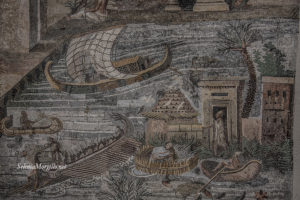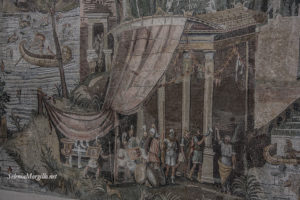The Nilotic Mosaic of Palestrina
Italian Version Below*
Praeneste (modern Palestrina) was one of the most famous cities in Lazio, founded before Rome, militarily strong and a remarkable cultural center.
Establishing its date of birth is an arduous task. The only sure thing is the great consideration that the ancients had for Praeneste to which mythical roots were attributed.
Inside the Archaeological Museum of Palestrina (housed in Palazzo Barberini) the amazing Nilotic Mosaic (or Nile) is visible.
The Nilotic Mosaic was made in Praeneste by Alexandrian artists in the 2nd century BC. Its re-discovery took place in the early 17th century.
Originally it was the floor of the apse of a building that overlooked the ancient square of the forum of Praeneste, known as Aula Absidata, part of a monumental complex built in the second century BC and dedicated to the cult of an Egyptian divinity, perhaps Isis or Serapis.
The mosaic represents a large geographical map of Egypt in perspective view, the Nile is recognized during the flood in its path of Upper Egypt, the wild territory of Nubia, a great variety of animals with names written in Greek, large temples pharaonic, the port of Alexandria in Egypt.
It is a rare example of Hellenistic mosaic, perhaps derived from a pictorial original from the time of Ptolemy Philadelphus, in which an allegory of Egypt would be read under the rule of the Ptolemies.
Info: Palestrina Archaeological Museum
All rights reserved*
Praeneste (la moderna Palestrina) era una delle città più famose del Lazio, fondata prima di Roma, forte militarmente e notevole centro culturale. Stabilire la sua data di nascita è un compito arduo. L’unica cosa certa è la grande considerazione che gli antichi nutrivano per Praeneste alla quale venivano attribuito radici mitiche.
All’interno del Museo Archeologico di Palestrina (ospitato nel Palazzo Barberini) è visibile lo strepitoso Mosaico Nilotico (o del Nilo). Il Mosaico Nilotico fu realizzato a Praeneste da artisti alessandrini nel II secolo a.C.
La sua ri-scoperta avvenne agli inizi del XVII secolo. In origine era il pavimento dell’abside di un edificio che si affacciava sull’antica piazza del foro di Praeneste, nota come Aula Absidata, parte di un complesso monumentale realizzato nel II secolo a.C. e dedicata al culto di una divinità egiziana, forse Iside o Serapide.
Il mosaico rappresenta una grande carta geografica dell’Egitto in veduta prospettica, si riconoscono il Nilo durate l’inondazione nel suo percorso dell’Alto Egitto, il territorio selvaggio della Nubia, una grande varietà di animali con i nomi scritti in greco, grandi templi faraonici, il porto di Alessandria d’Egitto.
E’ un raro esempio di mosaico ellenistico, derivato forse da un originale pittorico dell’epoca di Tolomeo Filadelfo, in cui si leggerebbe un’allegoria dell’Egitto sotto il dominio dei Tolomei.
Info: Museo Acheologico di Palestrina
Sostieni #laculturachevince, aiuta la condivisione.



One Reply to “The Nilotic Mosaic of Palestrina”
Sono anni che desidero andarci…spero di vederlo presto dal vivo!